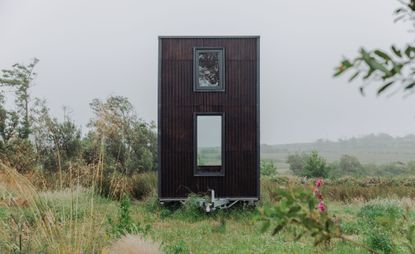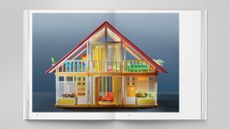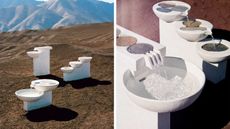These self-build Tiny Homes propose an alternative to renting
Irish social enterprise Common Knowledge is teaching people to build its Tigín Tiny Homes using sustainable materials
- (opens in new tab)
- (opens in new tab)
- (opens in new tab)
- Sign up to our newsletter Newsletter

Inside Tigín Tiny Homes
There have been lots of micro housing concepts created over the years to fight surging house and rental prices, yet most tend to disappear from the ether almost as soon as they emerge. Enter Tígín Tiny Homes, mobile small homes or cabins that don't pretend to be a future housing solution for all of us, but that are also refreshingly thoughtfully designed and gimmick-free.
The creators, an Irish social enterprise called Common Knowledge (tigín is Gaelic for a small house or cottage), have ensured the design has the same sort of specifications as a home extension or garden flat and that information about the eco-conscious and, in some cases, pioneering building materials and techniques used to build the home are freely accessible to all. That way, anyone thinking of embarking on a self-build or with access to land can make their own Tiny Home, or gain inspiration from it.
Inside Tigín Tiny Homes

‘We haven’t created these Tiny Homes as a new product,’ explains Fionn Kidney, co-founder and director of Common Knowledge. ‘We’ve actually only made four, but we have taught more than 250 people to build them on their own by involving them in the construction process during our Build Schools.’
The project is also about showcasing sustainable, quality materials that the team strongly believe should be more widely used.

These Tiny Homes are different in another way too. Though their footprint is small (20 sq m), they have tall ceilings (3.6m in the kitchen and living room areas), which, combined with oversized glazing, provide a constant connection to nature or views, while giving the sensation of more space. The homes also have clever storage solutions and use innovative or natural materials such as hemp corrugated panels and natural rubber linoleum floor tiles, in part to meet their own self-imposed low-emissions construction targets but also to keep the weight of the trailer down.
‘By choosing materials like natural cork insulation, planed dimensional lumber and marine-grade plywood, we were able to make our structural elements of the building also be our finishing touches,’ explains Harrison Gardner, who is behind the design and construction of the Tigín Tiny Homes. ‘Hardwood countertops and custom couches were made possible by us not wasting any of our weight allocation in plasterboard finishes.’

One area the team found hard to keep lightweight was the external cladding. The contemporary modern finishes of concrete board were too heavy, while all the affordable timber options also pushed them over the limit. In the end, they opted for hemp cladding, a natural alternative to corrugated steel, grown and supplied by Margent Farm in Cambridgeshire, England.
‘It was almost half the weight of some of our other options, was grown relatively locally (as far as cladding sources go) and is made of an extremely sustainable, carbon-negative material,’ says Gardner.

The Common Knowledge team are honest about how their micro homes will be used. ‘We see the Tiny Homes as the potential first step for many onto the housing ladder and believe they will suit certain people and certain stages of their lives,’ says Gardner. ‘Individuals or couples craving independence but not yet able to afford their forever home will find the Tigín to be a comfortable housing solution for several years, somewhere they can live rent-free and save towards the home of their future.’
When residents are able to graduate to their forever homes, the idea is they will take some of the Tiny Homes’ material palette and building know-how with them.
INFORMATION
-
 Remembering New York artist Daniel Brush, 1947 – 2022
Remembering New York artist Daniel Brush, 1947 – 2022In tribute to Daniel Brush, who has died aged 75, we revisit this 2020 Wallpaper* profile of the elusive New York artist by jewellery historian Vivienne Becker, who unravelled the secrets of his singular designs for her book, ‘Daniel Brush: Jewels Sculpture’
By Vivienne Becker • Published
-
 Interior design books championing shelf love
Interior design books championing shelf loveWelcome to the Wallpaper* guide of the best interior design books published in 2022 and beyond – a collection of riveting visual tomes to feed creative innovation, inspiration and imagination
By Rosa Bertoli • Published
-
 Christmas decorations from leading creatives and design brands
Christmas decorations from leading creatives and design brandsOur edit of contemporary Christmas decorations ranges from architect-designed festive ornaments to Christmas baubles by leading creatives
By Rosa Bertoli • Published
-
 Holistic co-working: WeWork Singapore is attentive to culture and lighting
Holistic co-working: WeWork Singapore is attentive to culture and lightingWeWork Singapore opens – a 21-storey flagship co-working space and the company’s second-largest globally
By Martha Elliott • Published
-
 It’s a Barbie world: new book charts the evolution of the Barbie Dreamhouse
It’s a Barbie world: new book charts the evolution of the Barbie DreamhouseMattel Creations and Pin-Up present ‘Barbie Dreamhouse: An Architectural Survey’, exploring the fantasy home’s evolution, from its first appearance in 1962 to its latest iteration in 2021
By Pei-Ru Keh • Published
-
 Afternoon Light is a new online destination for design discovery
Afternoon Light is a new online destination for design discoveryAfternoon Light online shop launches with an eclectic selection of design brands big and small
By Pei-Ru Keh • Published
-
 Lily Clark’s water fountains offered a moment of sensorial escapism at Design Miami 2022
Lily Clark’s water fountains offered a moment of sensorial escapism at Design Miami 2022Design Miami 2022: Lily Clark's ‘Farallon’ water fountains, part of the Stroll Garden installation, combine modernist inspiration and hydro engineering
By Maria Sobrino • Published
-
 Alcantara and Maxxi present Space Popular’s ‘Search History’, exploring the work of Aldo Rossi
Alcantara and Maxxi present Space Popular’s ‘Search History’, exploring the work of Aldo RossiAlcantara and Maxxi present design studio Space Popular’s exhibition, 'Search History' (until 15 January 2023), Aldo Rossi’s architectural theories reworked into an evolving landscape of spaces
By Martha Elliott • Published
-
 Virgil Abloh Securities reimagines Alessi kettle by Michael Graves and it’s a slam dunk
Virgil Abloh Securities reimagines Alessi kettle by Michael Graves and it’s a slam dunkVirgil Abloh Securities and Alessi create a new edition of Michael Graves’ classic kettle, offering a new point of view on a contemporary design icon
By Rosa Bertoli • Published
-
 UniFor unveils new Milan showroom by Herzog & de Meuron
UniFor unveils new Milan showroom by Herzog & de MeuronUniFor’s new Milan showroom in Herzog & de Meuron’s Fondazione Giangiacomo Feltrinelli on Viale Pasubio is ‘an open space in dialogue with the city’
By Cristina Kiran Piotti • Last updated
-
 Germane Barnes’ Miami Design District installation is a love letter to the city
Germane Barnes’ Miami Design District installation is a love letter to the cityDesign Miami 2022: Germane Barnes’ Miami installation pays tribute to the BIPOC residents of the city and is inspired by the Miami Carnival
By Maria Sobrino • Published










